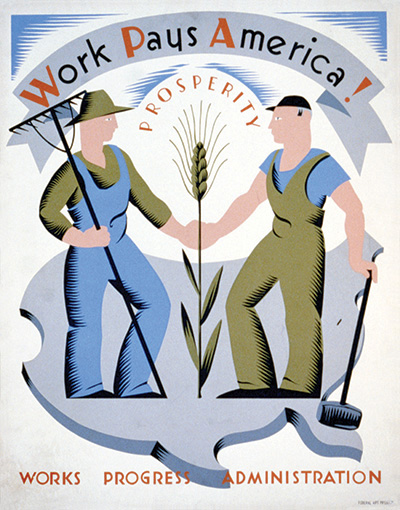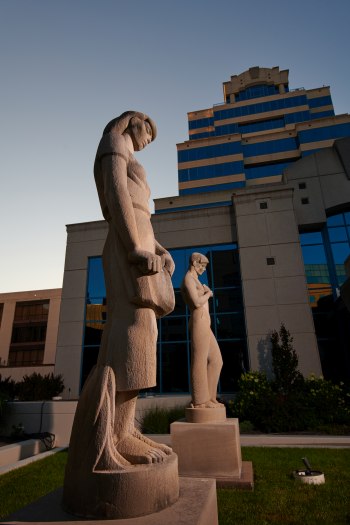Peace and Harvest: The WPA in Peoria

The 1929 stock market crash was a monumental event unlike anything America had previously experienced. Among other factors, it helped cause the Great Depression, catapulting the unemployment rate from three percent to a peak of nearly 25 percent in 1933. After a few years of struggle and turmoil, many Americans yearned for something, anything to bring stability back to their daily lives—and calm their fears that the hard times might never end.
Much as Americans had never experienced anything like this economic collapse, they had never experienced anything quite like President Franklin D. Roosevelt. His administration’s unique and profound ideas boosted the nation’s morale and moved the economy forward, while its legacy can still be seen throughout the country today.
Upon FDR’s arrival to the White House in 1933, he created what is now known collectively as the New Deal. A complex set of policies covering relief, reform and recovery, the New Deal set out to fix the economic crisis caused by the Great Depression by instituting so many acts and agencies that some referred to them as “alphabet soup agencies,” which was generally not a term of endearment. Complaints of government overreach and fears of a socialist or communist agenda were not uncommon from its opponents, while millions of others felt the government was finally providing essential financial assistance through its work-based programs.
 Creating Employment, Art and Infrastructure
Creating Employment, Art and Infrastructure
The mission of the Works Progress Administration, created in 1935, was to provide relief through paid work for the unemployed. Headed by Harry Hopkins, the WPA aimed to complete a wide range of community-based and community-requested projects throughout the United States. The agency employed over 8.5 million people throughout its eight-year duration. In Illinois alone, 200,000 people were employed by the WPA at any given time.
Despite the Roosevelt Administration’s desire to create an equal standard, the general pay was often lower than regular wages, and lower still for women, while African Americans were often subjected to racial discrimination from the communities in which they worked. Despite these shortcomings, the WPA’s slate of programs—which varied wildly from roads, bridges, schools and libraries to a wide range of arts and cultural projects—assisted many Americans who had lost the means to carry on their livelihood.
Among the WPA’s most unique components was Federal Project Number One, or Federal One, which encompassed four programs: the Federal Arts Project, Federal Writers’ Project, Federal Theatre Project and Federal Music Project. Its ambitious goal was to employ skilled workers to create lasting works of value—injecting creativity into communities that may not otherwise have had the opportunity and developing community assets through art. Although criticized for spending government money on projects unrelated to infrastructure, Federal One was an extremely successful program that employed some 40,000 artists, musicians, actors and writers in its prime.
Across the country, thousands of pieces of art were created through Federal One—from paintings, sculptures and lithographs to scripts, travel guides and oral histories, including an important collection of more than 2,000 narratives of former slaves. Federal One ended as a federally-sponsored program in 1939, although some of its projects were carried on as state-sponsored programs. By the time the United States entered World War II in 1941, however, nearly all WPA programs had been halted.

Peace and Harvest: A Legacy
On a warm September afternoon in 1939, Peoria’s only WPA-supported artwork was unveiled to the public outside the Peoria Municipal Tuberculosis Sanatorium on Forest Park Drive. The two sculptures, entitled Peace and Harvest, depict a male with a dove in his right hand and a shovel in his left (Peace), and a female holding fruit in her apron (Harvest). Hand-carved from Indiana limestone, the pair of heroic figures stood larger than life at eight feet tall.
The project was first announced in the winter of 1937 by Julia Proctor White, a civic leader and educator who solicited funds to cover the $185 cost of materials and their transportation from Chicago to Peoria. The funds were donated by Dr. George Zeller, superintendent of the Peoria State Hospital in Bartonville, and the two sculptures were completed by sculptor Mary Andersen Clark (1910-1994) in 1939. Clark came from a prominent Chicago art-world family and had studied at Carnegie Tech, the Art Institute of Chicago, and the British Academy in Rome, Italy. She was married to Horace Clark, whose parents lived in Peoria. During the opening celebrations, a letter read on behalf of the late Dr. Zeller (who had passed away the year prior) expressed “hope [that] the statues would be a source of inspiration to the sanitarium’s patients and would observe the silence maintained in the building.”
When the sanatorium closed in 1975, Peace and Harvest were removed from the grounds and taken to Bradley University for storage and restoration. The late Nita Sunderland, a Bradley professor and acclaimed sculptor, handled the restoration, and in 1988 the two sculptures were placed outside the Peoria County Courthouse. They were subsequently added to the National Register of Historic Places, but soon lost this status when they again had to be moved due to a courthouse expansion project. The sculptures remained in storage until 1992, when they were installed at their current location at Becker Plaza and once again added to the National Register of Historic Places. They still stand tall today, while other WPA-commissioned sculptures of Clark’s are said to have been lost.

 A Wide-Ranging Legacy
A Wide-Ranging Legacy
Although Peace and Harvest were the only works of art to come to Peoria through the WPA, workers from the Federal Writers’ Project also spent time here, working with documents at the Peoria Public Library and gathering information for the WPA Guide to Illinois (copies of which are still available at the library). In addition, precursor New Deal agencies such as the Public Works Administration supported efforts to build the Federal Building & U.S. Courthouse—with its four limestone relief panels—in downtown Peoria.
The Works Progress Administration not only delivered the largest of the federal relief programs, it was one of the last visual art programs supported by the New Deal. Today, what remains of WPA-funded buildings and cultural programs help tell the story of the Great Depression and the pre-war America of the 1930s. During this perilous time in history, artists were paid, livelihoods were met, and careers were established and advanced. The WPA’s wide-ranging legacy can still be found within our communities… if you know where to look. PM
Lottie Fiddes is Curator of History & Registrar at the Peoria Riverfront Museum.
- Log in to post comments

